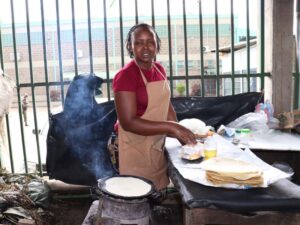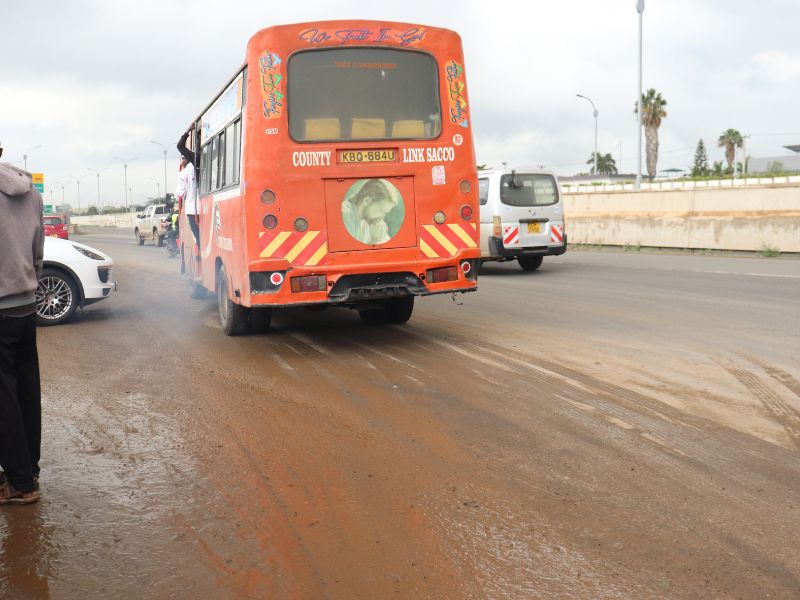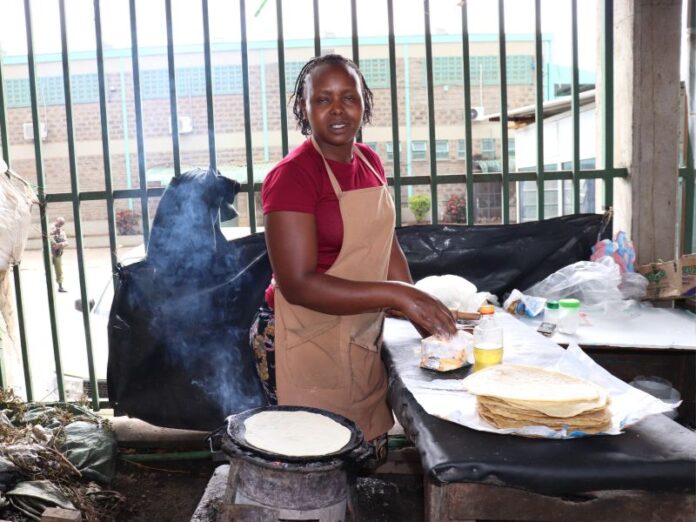By Dominic Kirui
Nairobi, Kenya: On a busy Tuesday morning at Cabannas bus stage east of Kenya’s capital, Nairobi, matatu (public service vehicles) touts shout at the top of their voices and bang the bus bodies as they call passengers to the buses.
As they scream for customers, the bus drivers accelerate the buses to create the impression that they will leave soon. As they do, they engulf the touts, traffic police, passengers, and street vendors in black soot from the exhaust systems.
Alice Mutoko, a 32-year-old mother of two has been working for two years just about three metres from the bus stage, cooking food for sale to the people around it.
As she uses a charcoal stove to cook chapati, she inhales the carbon monoxide from the burning charcoal, the soot from the raving bus engine exhausts, and also dust from the busy road, She is directly facing the soot from the buses.
As a result, Mutoko says that she is constantly coughing and on medication.

“I am used to this but I am coughing like four days a week; I have no choice because I have children depending on me,” Mutoko says.
The busy traffic at the bus stage contributes to air pollution around Nairobi, a city ranked one of the most polluted around the world, with the United Nations Environmental Programme (UNEP) saying that most drivers leave their engines running as they wait for passengers, which tends to pollute the city as more emission happens.
The pollution witnessed at the Cabannas bus stage is just the tip of the iceberg, as thousands of other vehicles in Nairobi, as well as other sources of indoor and outdoor pollutants, send small, harmful particles into the atmosphere.
These particles, called particulate matter (PM) penetrate the human body and cause respiratory, and cardiovascular diseases, and even cancer that can at times result in death when they penetrate and lodge deep in the lungs.
The particles can be measured in microns, with 10 microns or less being referred to as PM 10, and those of 2.5 microns as PM 2.5.

The World Health Organisation of the United Nations (WHO) estimates that in 2019, ambient (outdoor) air pollution in both cities and rural areas caused 4.2 million premature deaths worldwide due to exposure to fine particulate matter.
According to the organization, those in low- and middle-income countries disproportionately experience the burden of outdoor air pollution with 89% (of the 4.2 million premature deaths) occurring in these areas. This is mostly in South-East Asia and Western Pacific Regions.
Across the footbridge and on the opposite side of the road, Amos Wasike, a street vendor is busy wiping clean his soda packed in plastic bottles as he arranges them for display to attract customers boarding buses towards the city CBD.
Like Mutoko, Wasike has also been selling them for the past two years after he lost his job at a flower farm in Kericho County.
Wasike says that, as compared to his life in Kericho, Nairobi’s environment is so polluted because of the congestion and the vehicles emitting smoke.
“The atmosphere in Kericho is immaculate. The trees and plantations there ensure the air is clean, and there are not many cars like in Nairobi. Even though I worked in a flower farm that has got too many chemicals, the company provided protective gear for us. Here, you’re on you,” he says.
Wasike vends his goods at the bus stage heading into the city’s central business district. He wakes up early to catch commuters heading to work in the morning and stays late so he can sell to those returning home.
“Here, I inhale a lot of bad fumes from the buses and vans going into town, but what option do I have? The cost of living is high and I have to struggle to put food on the table, not even send my children to school,” Wasike says.
Organizations are working with universities in Nairobi and Kampala to monitor air quality in African cities including Nairobi. They have produced low-priced air quality monitors that keep air quality data over time.
Gideon Lubisia, the embedded systems and network support engineer for International operations at AirQo says that the monitors are now in eight African countries.
The low-cost monitors are now deployed in eight African countries. They send data to a mobile app that one can download and install on their phones and they can just see the air quality in different parts of their cities,” Lubisia says.
Dr. George Mwaniki, the Head of Air Quality at the World Resources Institute says that Nairobi began well and is now sliding back to the dark side of pollution.
“If you look at how estates like Buruburu were designed, there were so many green spaces, and that would ensure cleaner air. Estates coming up right now is basically a concrete jungle; we are doing quite badly,” he says.
Mwaniki adds that one of the biggest challenges for Nairobi is its air quality, and that thus says more about how it’s managed.
“You can actually tell how a city is being managed based on their air quality,” he says.














